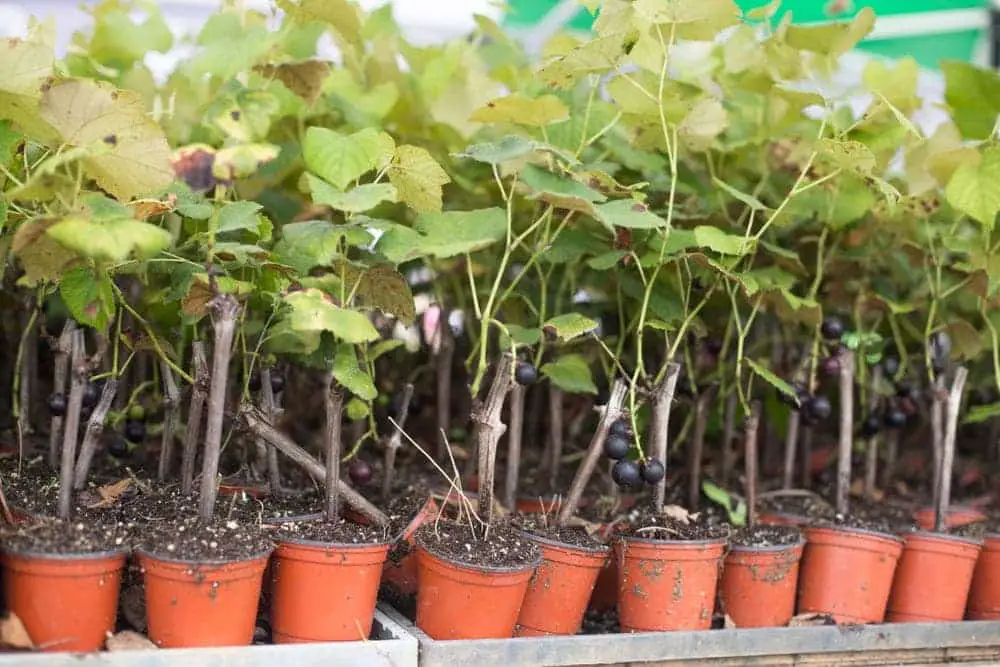Grapes are generally viewed as crop plants, but will grow enthusiastically in containers in most zones.
Container grapes will require a large pot with excellent drainage, full sun, and a strong, durable trellis. Careful pruning will yield the most productive plants. Mildew and fungus are common issues that can be mitigated with good air circulation and prudent watering.
Container-Friendly Varieties
Grapes are vigorous growers and most varieties will be perfectly happy in containers. Popular choices include concord and flame seedless. Pixie Pinot Meunier grapes are a great choice for small spaces! Dwarf cultivars like Pixie are arguably easier to grow in containers, as they will require the least amount of vine training and maintain a compact size. Choose a variety that does well in your zone and is highly resistant to disease. Most grapes are self-pollinating, so with proper care, a single plant can produce fruit.
Container Requirements
Grapes are large and vivacious plants, so they will require large containers for optimal growth. Choose a sturdy 15 gallon container that is at least 18-24” in diameter. Opt for a light-colored or ceramic pot to prevent overheating. A dark-colored or plastic container can absorb too much heat from the sun and damage the roots. Any container you select for growing grapes must have excellent drainage.
1. Soil
Table grapes prefer well drained soil that is rich in organic matter. First, layer the bottom of your selected pot with stones or gravel to promote good drainage. A second layer of mulch or organic material is ideal. Use good-quality potting soil and check the requirements for your chosen variety for correct pH requirements. A light layer of mulch on top of the soil will protect the roots from temperature fluctuations.
2. Light and Water
Keep your container grapes in a warm and sunny area. Grapes require full sun (at least 6 hours of direct sunlight every day) in order to produce fruit. More sunlight will provide a more bountiful harvest! Grapes are vulnerable to fungus and mildew, so it is imperative to provide good air circulation. Shelter your container grape from the wind. Grapes will grow in zones 3-10 and are hardy in zones 4-9. Move potted plants indoors during the winter.
Water frequently while the plant is getting established. Keep the soil moist, but never allow it to become soggy. Overwatering will promote fungal diseases and damage your plant. An established plant will tolerate dry soil followed by deep watering. When the soil becomes noticeably dry, water every 1-3 days to keep moist. then allow the roots to dry out after several years.
Propagating Cuttings in Containers
Most grapes are grown from cuttings. To begin, select a cutting from the old hardwood of an established plant. Take the cutting in early spring while the plant is dormant. A pencil-sized cutting about 12” in length with at least 3 leaf nodes will be best. Grapes root easily but can be encouraged by dipping the cut end in the root hormone. Plant the root end in sterile potting soil and keep moist, but not overwatered. Maintain good drainage while your cutting grows.

Support
All grapes require training and support and container grapes are no different. After the first frost, train your grapes on a tall, sturdy trellis. When choosing a trellis, pay special attention to the strength and durability as the plants will live for years. Tall trellises are a good choice, as are fan trellises.
For added strength, try placing your container-grown grapes along a wall or fence. Supporting the grape vines is vital for growing healthy and attractive plants. The Umbrella Kniffen training method is a well-established system that is especially successful with grapes grown in containers. As the plant grows, train green flexible vines along the trellis or support, carefully removing suckers and offshoots.
Pruning
Container grapes require aggressive pruning. Maintain one central trunk and allow only two or three vines to grow off of it. As the plant grows, prune early in the year before leaves appear. Keep the vines small and remove runners and suckers as they appear.
Growing grapes in a container limits the space allotted for root growth, so maintaining only a few small vines will encourage the plant to devote more energy towards producing high quality fruits than to growing more and larger vines.
Fertilizer
Established grapes do not require much fertilization, but will benefit from side dressing with manure or low-nitrogen fertilizer once or twice in the summer. Use a small amount of phosphorus fertilizer to encourage more blooms. More blooms means more fruit!
Fruit
Grapes do not fruit their first year. Dedicate the first year of growing your potted grapes to training the vines and careful pruning. Keep only a few vines growing off the central trunk. Allowing the plant to spread too much will discourage blooming. Most grapes are self-pollinating, so a healthy plant will bloom and produce fruits on its own. Expect only a few bunches of grapes the first year of fruiting. Enjoy the fruits of your labors in late summer/ early autumn.
Repotting
Repotting container-grown grapes is not only difficult, it is not recommended. That said, they can be successfully transplanted into the soil to grow larger and more productive vines.
Also read: How To Transplant & Move A Fern
Troubleshooting
Fungus is most damaging to grapes, even in containers. It is imperative to keep the roots well-drained to prevent fungus and rot. The first line of defense is to increase air circulation around the plant, fruits, and roots. Ensure that the soil does not become overwatered and the pot maintains good drainage.
If mildew should appear on the fruit, increase air circulation by moving the pot to a more open area and removing the leaves that touch the fruit if necessary. Protect the fruits from wasps and birds with a net. Aphids and Japanese beetles can also damage the plant.
Conclusion
Growing grapes in containers can be rewarding and easy. There are hundreds of grape varieties and will grow in almost any zone. With ample sunlight, a strong trellis, precise pruning, and careful watering, you can enjoy fresh grapes right on your patio.
Keep reading:
Victoria is the owner and main author of hobby plants. She loves spending her free time in her garden planting and taking care of her plants. Victoria hopes you enjoy the content here!

![The Best Stylish Grow Lights for Indoor Plants [REVIEWED] The Best Stylish Grow Lights for Indoor Plants [REVIEWED]](https://www.hobbyplants.com/wp-content/uploads/2022/07/stylish-grow-lights-for-indoor-plants-300x158.jpg)
